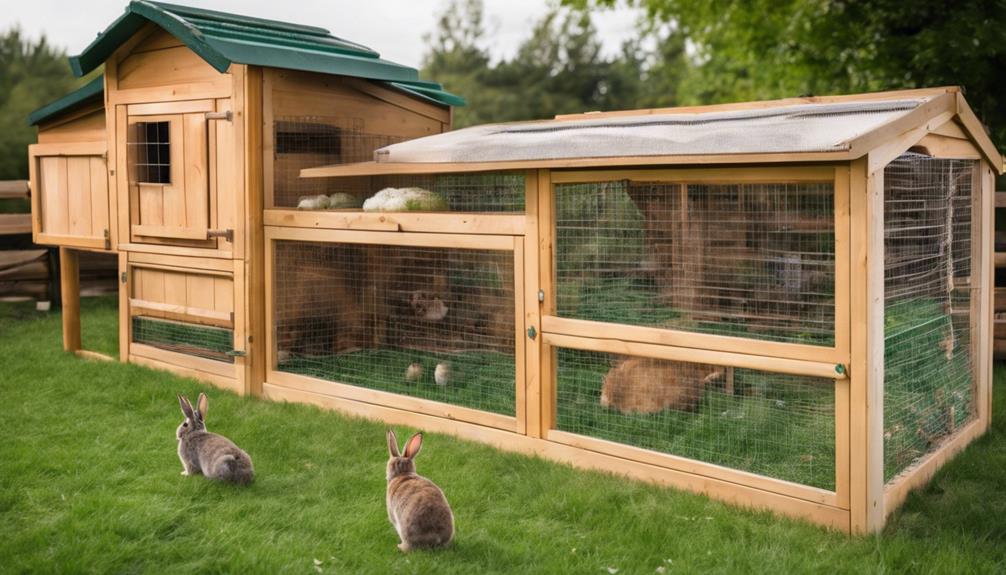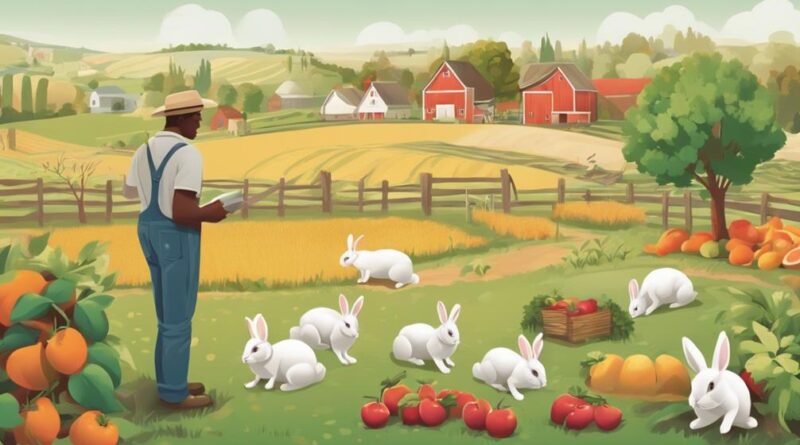10 Tips: Leveraging Rabbits for Sustainable Agriculture
Maximize your sustainable farming with these tips: integrate rabbits for soil fertility, use their manure for natural fertilization, employ them for pest control and soil aeration, rotate their grazing for efficient pasture utilization, include them in crop rotation for even nutrient distribution, provide suitable housing for their well-being, incorporate them in agroforestry to manage vegetation growth, utilize rabbit meat and fur sustainably, focus on breeding desirable traits. Revolutionize your agricultural practices by leveraging the unique benefits of rabbits to enhance productivity and sustainability.
Benefits of Integrating Rabbits in Farming
Integrating rabbits into farming practices can significantly enhance soil fertility and reduce the need for chemical fertilizers. When allowed to forage, rabbits play a crucial role in maintaining the health of the soil. Their foraging benefits include natural tilling of the soil through digging, which helps aerate the ground and improve water infiltration. Furthermore, as rabbits graze on grass and weeds, they act as natural lawnmowers, keeping vegetation in check and reducing the competition for resources with crops.
To maximize the benefits of integrating rabbits into farming, efficient waste management strategies are essential. Rabbit waste, also known as 'bunny berries,' is a valuable source of nutrients that can be used to fertilize crops. Implementing proper waste management strategies involves collecting and composting rabbit droppings along with bedding materials to create nutrient-rich compost. This compost can then be applied to the soil to improve its structure, increase microbial activity, and enhance nutrient availability for plant uptake.
Rabbit Manure as a Natural Fertilizer
Rabbit manure serves as an effective natural fertilizer rich in nutrients essential for enhancing soil quality and promoting plant growth. When used in farming, rabbit manure provides a sustainable way of enriching the soil due to its high levels of nitrogen, phosphorus, and potassium. These nutrients are crucial for plant development and are released gradually, reducing the risk of nutrient runoff.
One of the key advantages of utilizing rabbit manure is its composting benefits. When mixed with other organic materials such as straw, leaves, or kitchen scraps, rabbit manure accelerates the composting process, producing nutrient-rich humus. This compost improves soil structure, aeration, and water retention capacity, creating a healthy environment for plant roots to thrive.
Moreover, rabbit manure contributes to nutrient recycling in agriculture. By composting rabbit manure, you not only improve soil fertility but also reduce the need for synthetic fertilizers. This sustainable practice minimizes the environmental impact of farming by decreasing chemical inputs and promoting a more balanced ecosystem within the soil.
Utilizing Rabbits for Pest Control
To further enhance your agricultural practices, consider harnessing rabbits for effective pest control management. Rabbits can serve as valuable companion animals in your garden, offering natural protection against pests. Their presence alone can deter many unwanted visitors due to their scent and territorial nature. Additionally, rabbits can actively control pests by consuming insects and small rodents that may harm your crops.
One of the benefits of using rabbits for pest control is their natural digging behavior. Rabbits are known to dig burrows, which can help aerate the soil in your garden. This aeration improves soil structure, enhances drainage, and promotes better root growth for your plants. By allowing rabbits to roam in designated areas, you can take advantage of their digging instincts to benefit your garden's overall health.
When implementing rabbits for pest control, it's important to consider their specific needs and behaviors. Providing them with a secure enclosure that still allows them to move around freely is crucial. Additionally, ensure they've access to fresh water, appropriate shelter, and a balanced diet to support their pest control efforts effectively.
Implementing Rabbit Grazing Techniques
Consider implementing rotational grazing practices to optimize the efficiency of rabbit foraging in your agricultural operations. Grazing management is essential for maximizing the benefits of rabbit grazing. By dividing your pasture into smaller sections and rotating the rabbits between these areas, you allow for better forage utilization and give the vegetation time to recover, promoting healthier growth. This approach also helps prevent soil erosion and compaction by ensuring that rabbits don't overgraze any single area.
Incorporating grazing management techniques not only benefits the vegetation but also plays a crucial role in soil enrichment. As rabbits graze, their droppings provide a natural source of fertilizer, enriching the soil with essential nutrients. The rotational grazing system allows for a more even distribution of these nutrients across the pasture, promoting overall soil health and fertility. Additionally, the constant movement of rabbits helps to break up the soil, improving its structure and promoting better water infiltration and retention.
To effectively implement grazing management, carefully monitor the grazing patterns of your rabbits and adjust the rotation schedule as needed based on vegetation growth and recovery rates. By integrating these techniques into your agricultural practices, you can leverage rabbit grazing to not only benefit the vegetation but also enhance soil quality and overall sustainability on your farm.
Incorporating Rabbits in Crop Rotation
Enhance the efficiency and productivity of your crop rotation system by strategically integrating rabbits into your agricultural practices. Incorporating rabbits in crop rotation can bring significant benefits through rotational grazing and soil enrichment.
Rotational grazing with rabbits involves moving them to different sections of your farm in a planned sequence. By doing so, rabbits can graze on cover crops or weeds in one area while allowing other sections to regrow. This controlled grazing not only helps manage vegetation but also distributes nutrients more evenly across the land.
When rabbits graze, they deposit their droppings which are rich in nitrogen and phosphorus, essential nutrients for plant growth. As they move around the farm during rotational grazing, their droppings serve as a natural fertilizer, enriching the soil. This process enhances soil fertility, promotes microbial activity, and improves soil structure.
Integrating rabbits in crop rotation can also break pest cycles. For instance, rabbits can feed on insects or larvae that may harm your crops, reducing the need for chemical pesticides. Additionally, their constant movement helps disturb pest habitats, further aiding in pest management.
Enhancing Soil Health With Rabbit Droppings
Harness the potent nutrients in rabbit droppings to fortify soil health and bolster agricultural sustainability. Rabbit droppings are a valuable resource for enhancing soil health due to their high nitrogen content, essential for plant growth. When incorporated into the soil, rabbit droppings provide a slow-release nitrogen source, promoting robust plant development.
One key benefit of rabbit droppings is their exceptional composting potential. Their high nitrogen content helps balance carbon-rich materials like straw or wood chips, creating a nutrient-rich compost. This compost can then be used to enrich garden beds or crop fields, improving soil structure and fertility.
Moreover, rabbit droppings facilitate nutrient recycling within the agricultural ecosystem. By composting rabbit droppings along with other organic matter, you can create a closed-loop system where nutrients are continuously recycled back into the soil. This not only reduces the need for synthetic fertilizers but also minimizes waste production on the farm.
Incorporating rabbit droppings into your soil management practices can lead to healthier plants, increased yields, and improved soil structure. By recognizing the value of rabbit droppings and harnessing their potential for composting and nutrient recycling, you can take significant steps towards sustainable agriculture and long-term soil health.
Rabbit Housing for Sustainable Farming

To optimize the sustainability of your farming practices, establishing efficient rabbit housing systems is imperative for maintaining the health and productivity of your rabbit population.
When designing rabbit housing, consider the natural behavior of rabbits, such as their instinct to burrow. Providing suitable burrowing areas within the housing setup can enhance the rabbits' well-being. This can be achieved by incorporating tunnels or boxes filled with materials like hay or soil that allow the rabbits to exhibit this natural behavior, reducing stress and promoting overall health.
Furthermore, rabbit enrichment is crucial for ensuring the mental and physical stimulation of your rabbits. Enrichment activities can include providing them with toys like cardboard tubes or wooden blocks to chew on, as well as platforms or ramps for them to explore. These activities help prevent boredom and encourage natural behaviors, leading to happier and healthier rabbits.
When constructing the housing, ensure proper ventilation to prevent respiratory issues and maintain optimal temperature and humidity levels. Additionally, regular cleaning and disinfection of the housing are essential to prevent diseases and parasites. By incorporating elements that cater to rabbit burrowing instincts and providing enrichment opportunities, you can create a sustainable and healthy environment for your rabbit farming endeavors.
Integrating Rabbits in Agroforestry Systems
Integrating rabbits in agroforestry systems requires thoughtful planning to maximize the mutual benefits between the rabbits and the diversified tree-based agricultural practices. When considering rabbit integration, understanding rabbit foraging techniques is crucial. Rabbits are known for their selective feeding habits, preferring tender young shoots and leaves. This behavior can be advantageous in agroforestry settings as it aids in controlling weed growth and promoting plant diversity by preventing certain species from dominating the ecosystem.
One of the key agroforestry benefits of integrating rabbits is their role in nutrient cycling. Rabbit droppings are rich in nitrogen and phosphorus, essential nutrients for plant growth. By allowing rabbits to forage in agroforestry systems, their natural grazing and manure production contribute to soil fertility, reducing the need for artificial fertilizers. This sustainable practice not only benefits the plants but also enhances the overall ecosystem health.
Moreover, rabbit integration in agroforestry systems can help manage vegetation growth and reduce the risk of wildfires by controlling excess vegetation that could act as fuel. By strategically placing rabbit shelters and providing them with suitable foraging areas, farmers can harness the natural behaviors of rabbits to maintain a balanced and productive agroforestry environment. In conclusion, integrating rabbits into agroforestry systems presents a symbiotic relationship that supports sustainable agricultural practices and ecosystem resilience.
Using Rabbit Meat and Fur Sustainably

In the realm of sustainable agriculture, an efficient utilization of rabbit meat and fur can significantly enhance the overall value and productivity of rabbit farming systems. When considering rabbit welfare in meat production, it's crucial to ensure that rabbits are raised in humane conditions, provided with proper nutrition, space for exercise, and access to clean water. Implementing these welfare practices not only aligns with ethical standards but also contributes to the quality of the meat produced.
Fur production is another aspect to consider when utilizing rabbits sustainably. To ensure optimal fur quality, rabbits should be groomed regularly to prevent matting and maintain a healthy coat. Proper grooming not only enhances the appearance of the rabbits but also improves the quality of fur that can be harvested. Moreover, when harvesting fur, it's essential to do so in a manner that minimizes stress and discomfort to the rabbits. Utilizing the fur in products such as clothing, accessories, or insulation materials can add value to the overall sustainability of rabbit farming operations.
Rabbit Breeding for Agricultural Sustainability
How can breeding practices be optimized to enhance agricultural sustainability through rabbit farming? Genetic selection and strategic breeding practices are key elements in maximizing the potential of rabbit farming for sustainable agriculture. When aiming for agricultural sustainability, it's crucial to focus on enhancing desirable traits in rabbits through selective breeding.
Genetic selection plays a pivotal role in rabbit breeding for agricultural sustainability. By identifying rabbits with desirable characteristics such as high fertility rates, rapid growth, and disease resistance, farmers can establish breeding programs that promote these beneficial traits. Through careful selection of breeding stock based on their genetic makeup, farmers can gradually improve the overall quality of their rabbit populations.
Breeding practices also play a significant role in ensuring the sustainability of rabbit farming. Controlled mating, proper record-keeping, and monitoring of breeding outcomes are essential aspects of effective breeding practices. By closely managing the breeding process, farmers can track the genetic lineage of their rabbits, identify successful breeding pairs, and continuously improve the quality of their rabbit stock.
Frequently Asked Questions
Can Rabbits Be Effectively Used for Weed Control in Farming?
Yes, rabbits can be effectively utilized for weed control in farming. Their natural grazing behavior makes them efficient weed eliminators. Rabbit grazing can target specific areas, tackling weed removal in a sustainable manner.
How Do Rabbits Impact the Biodiversity of Agroforestry Systems?
When rabbits are introduced into agroforestry systems, they can play a vital role in enhancing soil enrichment and biodiversity. By foraging on vegetation and leaving behind droppings rich in nutrients, rabbits contribute to soil fertility.
Additionally, their presence can help manage pests by reducing weed growth and controlling insect populations. This interplay between rabbits and the ecosystem highlights their potential to positively impact agroforestry practices.
Are There Specific Regulations for Using Rabbit Manure in Organic Farming?
When considering organic farming, regulations play a crucial role in managing inputs like rabbit manure. Sustainable agriculture relies on compliance with these guidelines to ensure environmental and consumer safety.
Understanding the specific regulations related to using rabbit manure is essential for maintaining organic certification. By adhering to these standards, farmers can leverage the benefits of rabbit manure effectively in their sustainable agricultural practices.
What Are the Potential Risks of Incorporating Rabbits in Crop Rotation?
When incorporating rabbits in crop rotation, potential risks include disease transmission from rabbits to crops and predation on the crops by rabbits. However, the benefits of improved soil fertility and erosion prevention through rabbit manure outweigh these risks.
Proper management practices can help mitigate these risks, such as maintaining a healthy rabbit population and ensuring proper sanitation to minimize disease spread. Consider these factors when integrating rabbits into your sustainable agriculture practices.
How Can Rabbit Breeding Practices Contribute to Agricultural Sustainability?
To enhance agricultural sustainability through rabbit breeding, focus on genetic diversity in breeding programs. This approach can lead to robust rabbit populations with desirable traits.
Additionally, consider habitat restoration as part of conservation efforts. By creating suitable environments for rabbits, you can support their well-being and contribute to ecosystem balance.
Integrating these strategies can optimize rabbit breeding practices for long-term agricultural sustainability.
Conclusion
In conclusion, by integrating rabbits into your farming practices, you can benefit from their manure as a natural fertilizer and utilize them for pest control. Implement grazing techniques and incorporate them in crop rotation to improve soil health. Provide housing for sustainability and integrate them in agroforestry systems to enhance overall farm productivity. Utilize their meat and fur sustainably and breed them for agricultural sustainability.
Leveraging rabbits in sustainable agriculture can help reduce reliance on chemical inputs and improve soil health. This approach enhances farm productivity in an environmentally friendly manner.
